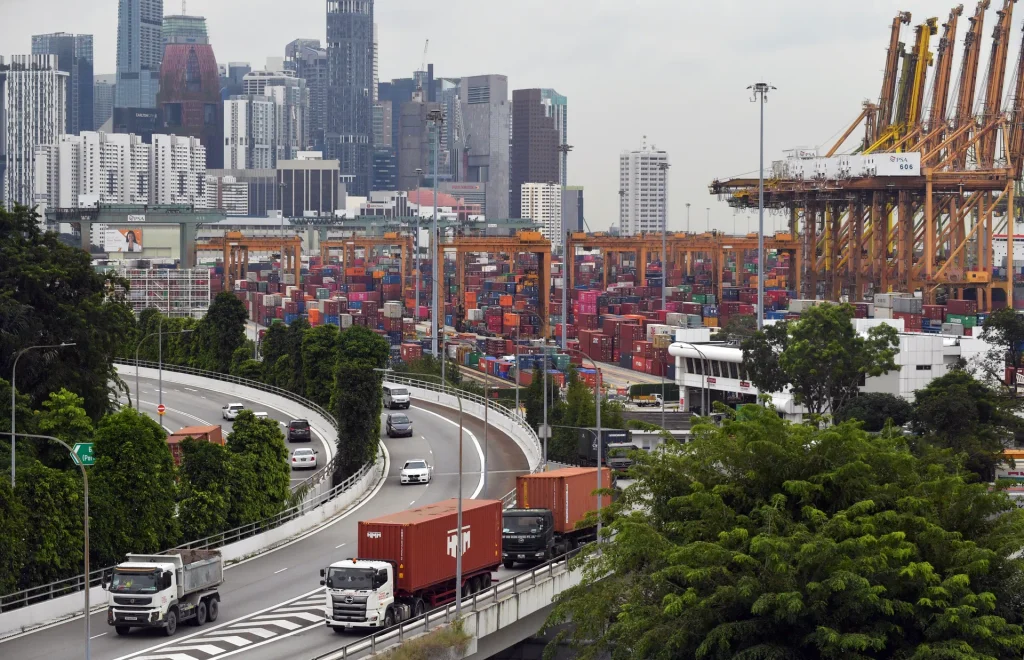[SINGAPORE] Economists warned that the Republic’s key exports may still ease in the remainder of the year, despite the stronger-than-expected rebound reported in September.
The latest non-oil domestic exports (NODX) print marked a 6.9 per cent expansion year on year in September, reversing from the preceding month’s upwardly revised 11.5 per cent drop, data from Enterprise Singapore (EnterpriseSG) showed on Friday (Oct 17).
It also surprised private-sector economists – the consensus in a Bloomberg poll was for the decline to be extended, with a 2.1 per cent fall on a yearly basis.
Jester Koh, UOB associate economist, said: “The resilient September NODX performance aligns with the uptick in the new export orders sub-index of both the overall Purchasing Managers’ Index (PMI) and electronics PMI.”
But economists agreed that while the negative impacts of US tariffs seem to be controlled for now, NODX may still moderate at the end of the year.
On a seasonally adjusted monthly basis, NODX grew 13 per cent, in a turnaround from August’s 9.1 per cent contraction.
BT in your inbox

Start and end each day with the latest news stories and analyses delivered straight to your inbox.
Electronics and non-electronics exports both marked growth on a yearly basis.
Year on year, electronics exports jumped 30.4 per cent, following the preceding month’s 6.5 per cent drop. The latest figure, which came on the back of low base effects, was the strongest expansion since August 2024.
Integrated circuits (34.9 per cent), PCs (58.3 per cent) and disk media products (42.9 per cent) contributed the most to the expansion.
SEE ALSO

“This possibly reflects the diffusion of artificial intelligence (AI) technologies into consumer devices, along with attendant spillover effects on memory-related demand,” said Koh, while DBS senior economist Chua Han Teng noted still resilient external demand bolstered by positive AI-related developments and US tariff exemptions for such products.
Spillovers from global AI-driven investment demand have led to electronics’ “clear outperformance” relative to non-electronics, seen across various indicators, added Koh.
Non-electronics shipments rose 0.4 per cent, after August’s 13.3 per cent tumble. The main growth drivers were non-monetary gold (82.7 per cent) and specialised machinery (14.1 per cent).
For the first nine months of 2025, overall NODX growth was 2.2 per cent year on year.
DBS’ Chua said Singapore’s non-oil re-exports (NORX), which serves as a better indicator of front-loading momentum, “demonstrated resilience”, while Koh marked the acceleration of electronics NORX.
Koh said that this suggests that front-loading effects may linger in anticipation of potential US semiconductor tariffs. Previously-announced 100 per cent US tariffs on branded or patented pharmaceutical products, which were planned to take effect from Oct 1, are now delayed, he added.
While Chua agreed that front-loading of electronics goods could continue until the threatened semiconductor tariffs are implemented, non-electronics front-loading is likely to wane, “amid the implementation of higher US reciprocal tariffs from August and a likely payback from an earlier boost”.
He believes that, despite September’s upside surprise, Singapore’s exports showed signs of easing in the third quarterm though not a severe downturn.
“While the negative impact from US tariffs appears to be contained for now, we remain cautious on the outlook over the coming quarters as downside risks persist,” he said, flagging contentious US-China trade relations – with a re-escalation of tensions in October – and Trump’s sectoral tariffs.
Performance by market
In September, key exports to all but three of Singapore’s top 10 markets rose.
The three markets for which NODX fell year on year were Indonesia (-10.7 per cent), the US (-9.9 per cent) and the European Union (-20.5 per cent). Indonesia and the US had marked double-digit falls in August, but the EU had double-digit year-on-year growth in the preceding month.
“Despite the positive headline NODX numbers, Singapore’s NODX to the US continued to be negatively hit by US reciprocal tariffs,” said DBS’ Chua, noting that September marked the fifth consecutive month of declines in NODX to the US. “Notably, non-electronics domestic shipments to the US shrank by double-digits of 23.6 per cent year on year.”
In contrast, NODX to all other markets posted growth in September. This was led by Hong Kong at 56.3 per cent, followed by Taiwan (31.9 per cent) and China (10.1 per cent). Thailand also recorded double-digit growth.
Overall, total trade grew 14.9 per cent year on year in September, following the previous month’s 2.9 per cent increase. Total exports rose 15 per cent, up from August’s 1.8 per cent; total imports were up 14.8 per cent, up from the preceding month’s 4 per cent.


